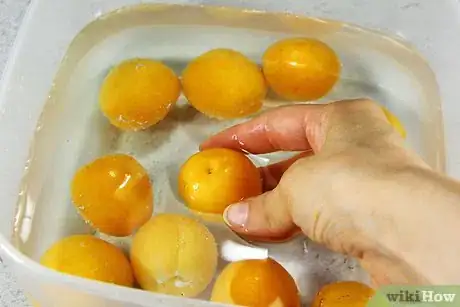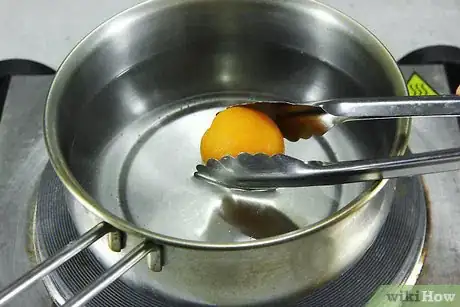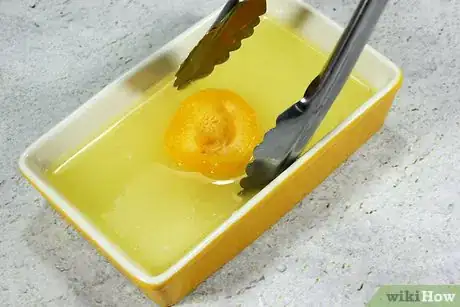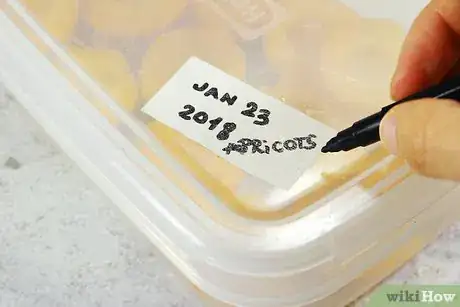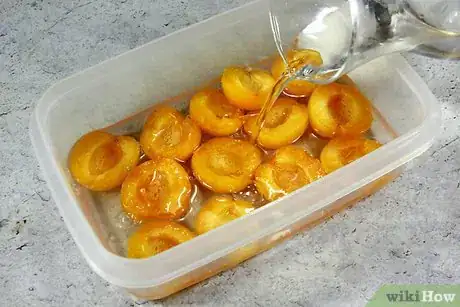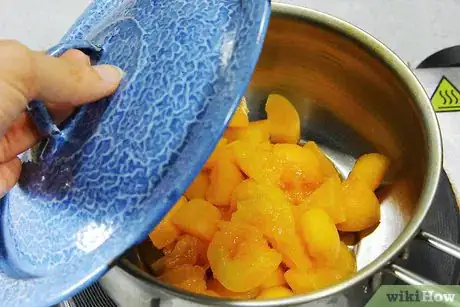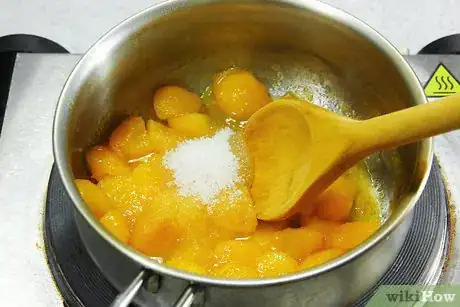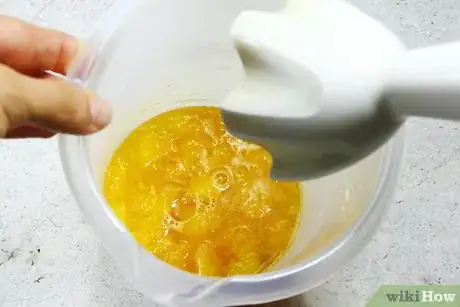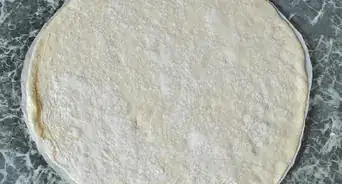This article was co-authored by wikiHow staff writer, Amy Bobinger. Amy Bobinger has been a writer and editor at wikiHow since 2017. She especially enjoys writing articles that help people overcome interpersonal hurdles but frequently covers a variety of subjects, including health and wellness, spirituality, gardening, and more. Amy graduated with a B.A. in English Lit from Mississippi College in 2011 and now lives in her hometown with her husband and two young sons.
wikiHow marks an article as reader-approved once it receives enough positive feedback. In this case, 93% of readers who voted found the article helpful, earning it our reader-approved status.
This article has been viewed 50,200 times.
Learn more...
Apricots are a sweet, delicious stone fruit that typically ripens between the end of July and the middle of August. During the harvest season, you may find yourself with more apricots than you can eat at once. Luckily, you can easily freeze them so you can enjoy their flavor year-round!
Ingredients
- 1 quart (0.95 L) lemon or pineapple juice
- Sugar (optional)
- Water
- 3–4 ounces (85–113 g) sugar (optional)
- 4 US tbsp (59 mL) water
Steps
Blanching and Slicing Ripe Apricots
-
1Choose fruit that is fully ripe but still firm. When you squeeze it, a ripe apricot should indent slightly beneath your fingers, but it should not be overly soft. You can also smell near the fruit’s stem, since a ripe apricot will have a sweet scent.[1]
-
2Wash the apricots with a mixture of 3 parts water and 1 part vinegar. This rinse will help to remove any bacteria from the fruit. Rinse the apricots under cool running water and pat dry.[4]
- Washing the apricots before you boil them keeps contaminants from cooking into the fruit.
Advertisement -
3Blanch the apricots in boiling water if you are leaving the peels on. Bring a large stockpot of water to a boil, then drop the apricots into the water for between 30 seconds and 1 minute. This keeps the skins from becoming tough during the freezing process.[5]
- Do not overcook the apricots, especially if you are planning on freezing the fruit while it is fresh.
- If you are peeling the apricots, you don’t have to blanch them. However, it does make removing the peels easier.
- If you are freezing a large quantity of apricots, you may want to blanch them in smaller batches, depending on the size of your stock pot.
-
4Dip the apricots in ice-cold water after you blanch them, then drain and dry. After the apricots have boiled for 30-60 seconds, use a slotted spoon to remove the apricots from the boiling water. Plunge them into ice-cold water right away to immediately stop the cooking process, then drain them and pat them dry.[6]
-
5Peel the apricots unless you plan to leave the skins on. If you blanched the apricots, or if they are especially ripe, you should be able to easily remove the skins with your fingers. Otherwise, you can use a sharp paring knife to peel the fruit.[7]
- If you’re pureeing the apricots, you will need to remove the skins.[8]
-
6Slice the apricots in half and remove the pits. Use a small paring knife to slice through the fruit, sliding it around the pit. Twist the halves of the apricot to separate it, then use your fingers or a spoon to scoop out the pit. [9]
- If you’re freezing the apricots fresh, you can leave them in halves, or you can cut them into quarters or slices if you prefer.
Freezing Sliced Apricots
-
1Dip the apricots in lemon or pineapple juice. Apricots have a tendency to become discolored when they are exposed to air. By dipping them in a shallow plate filled with a citrus juice like lemon or pineapple juice, you can prevent them from blackening.[10]
- You can use any ascorbic acid or citrus juice, including powdered ascorbic acid or vitamin C tablets. However, lemon or pineapple juice will give the apricots a pleasing flavor and they are easy to find.[11]
- You’ll only need a splash of juice for each apricot, so a 1 quart (0.95 L) jar should be sufficient for a moderately-sized batch.
-
2Layer the apricots in freezer-safe containers. The best containers for freezing apricots are plastic containers with tight-fitting lids, especially if you’re going to pack the fruit in syrup. You can pack the apricots as tightly as your like without crushing them.[12]
- Leave at least 1⁄4 inch (0.64 cm) of headroom in the container to allow the apricots room to expand.
- If you’re not packing the apricots in syrup, you can place them in freezer-safe bags if you prefer.
-
3Label the containers with the name of the fruit and the date it was prepared. Using a stick-on label or a permanent marker, you should indicate that the fruit you're freezing is apricot, because it can be hard to differentiate fruit slices once they're frozen. Including the date on the label will help you keep track of when the apricots will expire.[13]
- Fresh apricots which are not packed in syrup will last in the freezer for up to 3 months.
-
4Pack the apricots in syrup for a longer shelf life. To prepare a heavy syrup for apricots, prepare a mixture of 80% water and 20% sugar. Mix the water and sugar together and bring to a boil, then pour over the raw fruits in the freezer-safe containers. Use 1 cup (240 mL) of syrup for each 1 quart (0.95 L) of prepared fruit [14]
Freezing Apricot Puree
-
1Slice the fruit into small chunks. Once you have washed, peeled, and pitted the apricots, use your paring knife to slice it into small pieces. The cuts don’t have to be perfectly even, since you’ll be pureeing the fruit after you cook it, but aim for pieces that are roughly 1 inch (2.5 cm) square.
-
2Simmer 1 pound (0.45 kg) chopped apricot with 4 US tbsp (59 mL) of water. Place the mixture in a saucepan, cover it, and turn it to medium-low heat. Allow the apricots to simmer until they are soft.[17]
- Depending on the ripeness, this may take anywhere from 5-15 minutes.
-
3Stir in 3-4 oz (85-115g) of sugar if you want to sweeten the puree. Apricots are tart, so you may want to add a little sugar to balance out the flavor of your puree. Use a long-handled spoon to stir the sugar into the mixture, and allow the apricots to continue simmering until the sugar is dissolved.[18]
- You can also use honey, brown sugar, or corn syrup if you prefer.
-
4Allow the mixture to cool, then puree it in a food processor or blender. Blend the mixture until it’s smooth, although you can leave it a little chunky if that’s the consistency you prefer.[19]
- You can also mash with a potato masher if you prefer a chunky puree or if you don’t have a food processor.[20]
-
5Pour the puree into plastic containers, leaving a little head room at the top. When the puree freezes, the moisture in the apricots will expand. Try to leave at least 1⁄4 inch (0.64 cm) of space at the top of the container to account for this.[21]
- Apricot puree will keep in the freezer for 6-8 months.
Community Q&A
Did you know you can get answers researched by wikiHow Staff?
Unlock staff-researched answers by supporting wikiHow
-
QuestionCan I freeze dried apricots?
 wikiHow Staff EditorThis answer was written by one of our trained team of researchers who validated it for accuracy and comprehensiveness.
wikiHow Staff EditorThis answer was written by one of our trained team of researchers who validated it for accuracy and comprehensiveness.
Staff Answer wikiHow Staff EditorStaff Answer
wikiHow Staff EditorStaff Answer -
QuestionAre apricots healthy?
 wikiHow Staff EditorThis answer was written by one of our trained team of researchers who validated it for accuracy and comprehensiveness.
wikiHow Staff EditorThis answer was written by one of our trained team of researchers who validated it for accuracy and comprehensiveness.
Staff Answer wikiHow Staff EditorStaff Answer
wikiHow Staff EditorStaff Answer -
QuestionWhere does the apricot come from?
 wikiHow Staff EditorThis answer was written by one of our trained team of researchers who validated it for accuracy and comprehensiveness.
wikiHow Staff EditorThis answer was written by one of our trained team of researchers who validated it for accuracy and comprehensiveness.
Staff Answer wikiHow Staff EditorStaff Answer
wikiHow Staff EditorStaff Answer
Things You'll Need
Preparing the Apricots
- Ripe apricots
- Vinegar
- Water
- Stock pot
- Bowl
- Slotted Spoon
- Paring knife
- spoon
Storing Fresh Apricots
- Shallow plate
- Freezer-safe containers or bags
Freezing Apricot Puree
- Paring knife
- Saucepan
- Blender, food processor, or potato masher
- Plastic freezer containers
References
- ↑ https://extension.usu.edu/canning/ou-files/FN-2004-Harvest-02.pdf
- ↑ http://www.cooksinfo.com/apricots
- ↑ http://www.cooksinfo.com/apricots
- ↑ https://www.parents.com/recipes/baby-food/how-to-make-apricot-puree-for-babies/
- ↑ http://www.cooksinfo.com/apricots
- ↑ https://www.parents.com/recipes/baby-food/how-to-make-apricot-puree-for-babies/
- ↑ http://www.cooksinfo.com/apricots
- ↑ https://www.parents.com/recipes/baby-food/how-to-make-apricot-puree-for-babies/
- ↑ http://www.cooksinfo.com/apricots
- ↑ http://www.cooksinfo.com/apricots
- ↑ https://extension.usu.edu/canning/ou-files/FN-2004-Harvest-02.pdf
- ↑ https://www.thekitchn.com/how-to-freeze-fresh-summer-fruit-cooking-lessons-from-the-kitchn-193051
- ↑ https://www.thekitchn.com/how-to-freeze-fresh-summer-fruit-cooking-lessons-from-the-kitchn-193051
- ↑ https://extension.usu.edu/canning/ou-files/FN-2004-Harvest-02.pdf
- ↑ http://www.cooksinfo.com/apricots
- ↑ http://www.cooksinfo.com/apricots
- ↑ https://www.helpwithcooking.com/food-storage/freezing-fruit.html
- ↑ https://www.helpwithcooking.com/food-storage/freezing-fruit.html
- ↑ https://www.helpwithcooking.com/food-storage/freezing-fruit.html
- ↑ https://www.parents.com/recipes/baby-food/how-to-make-apricot-puree-for-babies/
- ↑ https://www.helpwithcooking.com/food-storage/freezing-fruit.html
About This Article
To prepare your apricots for freezing, choose ripe apricots that are firm yet yield slightly when squeezed. Wash the apricots with a mixture of 3 parts water and 1 part vinegar, then rinse the fruits thoroughly and pat them dry. Use a paring knife to slice the apricots in half and remove the pits. For tips on freezing apricots fresh, keep reading!

